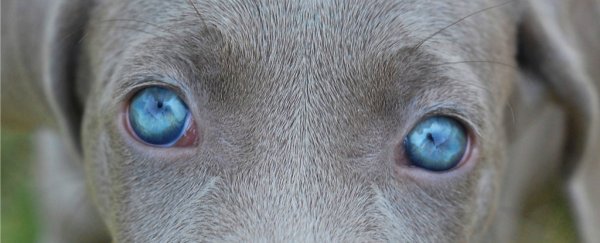Birds are able to navigate their way across thousands of kilometres to precisely the same spot year after year, thanks to their ability to perceive Earth's magnetic fields - a sense known as magnetoreception. Now researchers have shown that the eyes of dogs, certain primates, and bears contain the same molecule thought to be responsible for this ability in birds, suggesting that these mammals might be able to do the same thing.
The molecule believed to be responsible for this 'sixth sense' - one that humans have unfortunately lost - is known as cryptochrome 1a, and it's part of the group of light-sensing molecules that help bacteria, plants, and mammals to regulate their circadian rhythms.
Although certain mammals, such as bats and mole rats, are believed to sense magnetic fields (as displayed by their fancy navigational abilities) until now, no one has studied the presence of the magnoreception molecule in mammals.
Now a team of researchers led by the Max Planck Institute in Germany has shown for the first time that a mammalian version of this molecule, which they're simply calling cryptochrome 1, is present in the retinas of dog-like carnivores, such as dogs, wolves, bears, foxes, and badgers.
It was also present in the retinas of certain primates, including orangutans and some macaque species.
To be clear, simply having cryptochrome 1 doesn't necessarily mean that these animals are able to perceive magnetic fields like birds do - the molecule could be playing some other type of role in their eyes.
But the researchers have good reason to suggest that its presence is a sign of magnetoreception. For starters, the cryptochrome 1 they found was located in the outer segments of the mammals' blue- to UV-sensitive cone photoreceptors.
Why is that important? Because that's the same place the molecule is found in birds.
From there, it's believed that cryptochrome 1a is activated by magnetic fields, which sets off a chain reaction that allows the animals to detect them. This process is pretty complicated - and, fascinatingly, involves quantum mechanics - but the short story is that the cryptochrome 1 in mammals is exactly where you'd expect it to be to detect magnetic fields.
Secondly, based on its location at the edge of the mammals' cone cells, it was unlikely that it controls the circadian rhythm or acts as a visual pigment for colour perception, the researchers report. "Therefore, it is possible that these animals also have a magnetic sense that is linked to their visual system," the researchers conclude in Nature Scientific Reports.
So assuming that's true, what are these species using the ability for? That's not clear just yet, but it's well known that dogs prefer to poop along a north-south axis, and they're not the only ones that show some magnetic preference.
"When hunting, foxes are more successful at catching mice when they pounce on them in a northeast direction," George Dvorsky adds over at Gizmodo. "For primates, this built-in compass may help with bodily orientation, or it could be a vestigial evolutionary trait that's largely unused."
The big surprise for the researchers was the fact that, out of 90 mammalian species examined, only a few contained cryptochrome 1 - and this didn't include mammals known to navigate using magnetic fields, such as mice and bats.
But those mammals might navigate a different way, the researchers suggest, for example, by using magnetite - tiny ferrous particles found in cells that work sort of like a pocket compass. Birds also use these to figure out where they are.
The researchers now need to work out whether or not dogs, bears, and the primate species really are using the magnetoreception powers of cyrptochrome 1, or whether the molecule serves some other purpose in their eyes.
Either way, it's pretty fascinating to think that primate ancestors of ours, no matter how distant, might still have the ability to perceive the magnetic fields that have long been invisible to us. We're kinda jealous.
